Building and Optimizing a Notification System and Infrastructure
If you're reading this, you likely understand how important it is to send timely notifications to boost user interaction and grow your business. Whether you're notifying users about new messages, upcoming events, or status updates, having a reliable notification system is crucial.
Creating a notification system in-house is challenging. It requires detailed planning, development, and ongoing maintenance. This article will break down the main parts of a notification system. By the end, you'll understand what’s needed to build one in-house, the challenges you might face, and what approach suits your company best.
Key Components of a Notification System
A well-functioning notification system has several key parts that work together. Here’s a look at each part:

- Delivery Channels & Vendor Integrations:
Delivery channels are how notifications reach users. To maximize engagement, you need to support multiple channels like email, SMS, in-app messages, push notifications, WhatsApp, Slack/Teams, and automated calls. Integrating with these channels can be complex, requiring vendor evaluation, API integration, service quality checks, and fallback strategies.

- Templating Engine:
A notification system must create messages that fit each channel. Emails might include detailed information, while SMS should be brief. Push notifications can include multimedia and interactive elements. Managing templates involves handling copywriting, personalization, branding, dynamic content, multilingual support, and testing. A visual editor for non-engineers can help manage these templates.
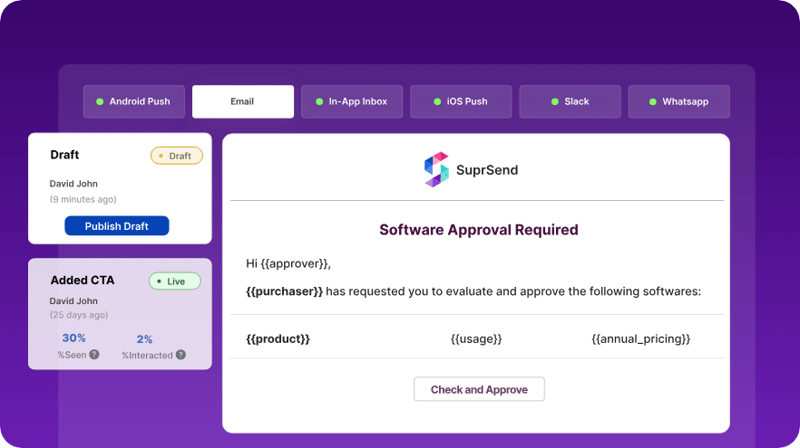
- User Preferences:
Proper targeting helps avoid notification fatigue and keeps users happy. Users should have control over what notifications they receive, how often, and through which channels. You need an easy-to-use interface for users to set their preferences, including types of notifications, channels, frequency, and timing. Allowing users to opt in or out of notifications helps prevent them from blocking all communications.

- Batching & Digest:
For some notifications, grouping several alerts into one message can be better than sending multiple separate alerts. For example, if there are several comments, it’s better to batch them and send them together. Summary digests can also be sent at user-preferred intervals (e.g., hourly, daily, weekly) to keep users updated without overwhelming them.
- Multi-Tenancy Support:
If your system serves multiple customers, it needs to handle multi-tenancy. This means isolating data, customizing notifications for each customer, and supporting branding and preferences for each tenant. For example, a SaaS platform sending invoices needs to use the customer’s branding and preferences in notifications.
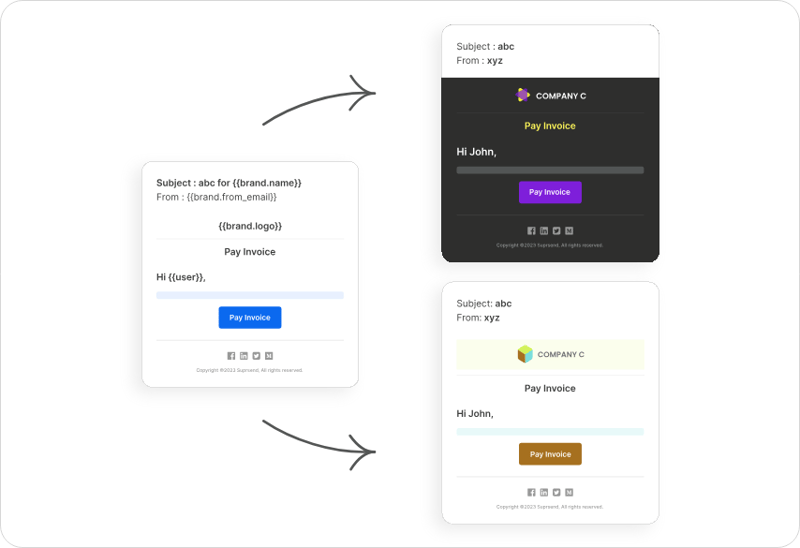
- Notification Analytics:
To improve notifications, you need to track their performance. Metrics like delivery rates, open rates, and user engagement are crucial. Different channels have different tracking methods, so standardizing how you measure user actions is important for effective analysis.
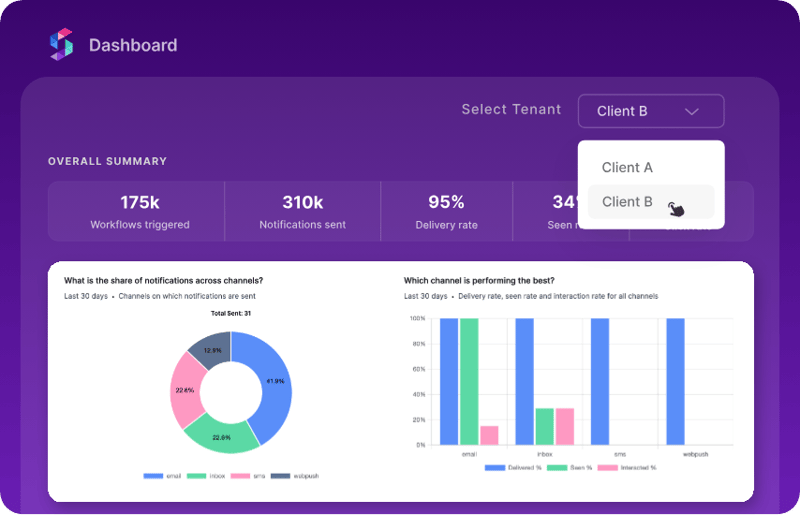
Non-Functional Aspects of Notification Systems
Reliable and efficient notification services also depend on several non-functional components:
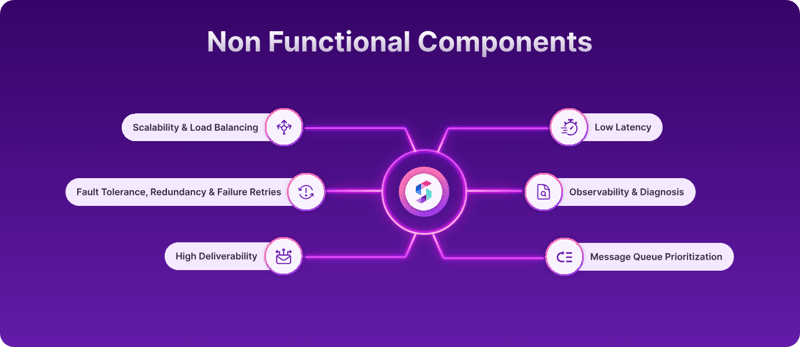
- Scalability & Load Balancing:
Notification services must handle varying levels of traffic. Ensuring scalability helps manage increased loads without performance issues. Load balancing across servers and regions keeps the service available and responsive.
- Fault Tolerance, Redundancy, & Failure Retries:
To avoid downtime, the system must have redundancy and failover plans. This includes managing state, using fallback vendors, controlling request rates, and retrying failed notifications when appropriate.
- High Deliverability:
Ensuring notifications are delivered successfully involves managing multiple channels, choosing reliable vendors, and handling bounce rates. Keeping channels clean and active improves deliverability.
- Low Latency:
Notifications should arrive quickly. Minimizing delay involves optimizing delivery routes, reducing network trips, and improving database queries. Continuous efforts are needed to maintain low latency as the system grows.
- Observability & Diagnosis:
Monitoring and diagnosing issues are essential for smooth operation. Implementing detailed logging, error tracking, and performance monitoring helps identify and resolve problems quickly.
- Message Queue Prioritization:
Not all notifications are equally important. High-priority notifications, like authentication alerts, should be sent immediately, while less urgent notifications, like newsletters, can be delayed. Prioritizing messages helps manage queue efficiency and control costs.
Deciding to Build or Buy
After understanding the components, you need to decide whether to build a notification system in-house or use an existing solution:
When to Build:
- Simplicity: If your notification needs are minimal and infrequent, a simple integration or a basic central service might work.
- Custom Needs: For highly specific requirements that third-party solutions can't meet, building a custom system is better.
- Core Product: If notifications are central to your product, having full control through an in-house system may be necessary.
When to Consider Alternatives:
- Resource Constraints: Limited engineering resources might make it more efficient to use existing services.
- Time to Market: Using third-party solutions can speed up development and launch.
- Complex Features: Established platforms often offer advanced features like workflows and cross-channel communication.
- Focus on Core Competencies: Using external services allows you to focus on your main business rather than the complexities of notification management.
SuprSend is designed to handle the complexities of notification orchestration for you.
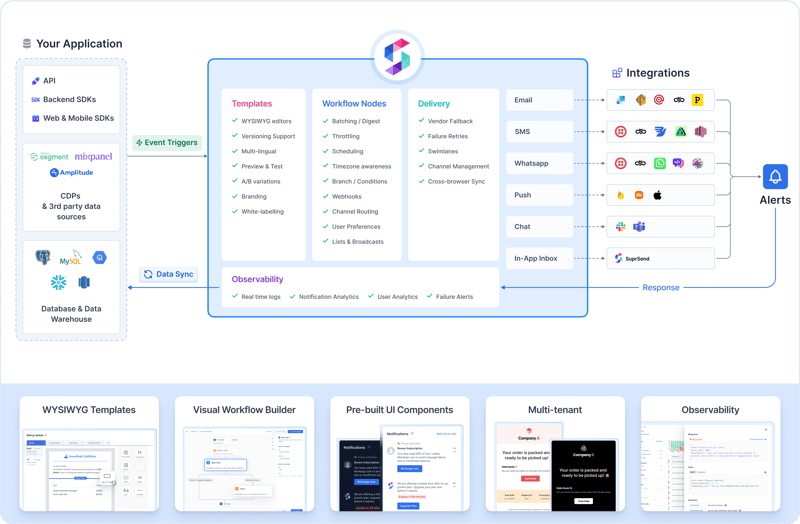
As an engineering leader, consider your company's needs, resources, and long-term goals when deciding whether to build a notification system in-house or use a third-party solution. The goal is to create a seamless and engaging user experience.
Check out more of our engineering insights here:
How Redis Solved Our Challenges with Dynamic Task Scheduling and Concurrent Execution
The problem statement was simple, or so we thought. In our previous setup, we used goroutines for scheduling database queries, allowing us to run the whole setup on minimal setup with SQLite and go service. Seems simple enough, but when we decided to also have this feature on our SaaS platform, at the onset, we didn’t realize we would also be walking into a new set of challenges of dynamic scheduling and concurrent task execution.
We needed a way to sync data in a scheduled manner from the client's data warehouse to our data store.Comparing Notification Infrastructure & Marketing Automation Tools
We discuss around when should one prefer marketing automation tools ike Braze, Cutomer.io and when does it make sense to check notification infrastructure tools like SuprSend.Dynamically Syncing In-App Notification Center Theme with Application's Current Theme State
Showcasing some customization capabilities of our app inbox notification centerEnhancing User Engagement with Notifications Channel Routing
Learn how to do efficient notifications channel routing, i.e, if email is unavailable send on SMS with smart logic.
-
 How to Fix \"mysql_config not found\" Error When Installing MySQL-python on Ubuntu/Linux?MySQL-python Installation Error: "mysql_config not found"Attempting to install MySQL-python on Ubuntu/Linux Box may encounter an error messa...Programming Posted on 2025-04-03
How to Fix \"mysql_config not found\" Error When Installing MySQL-python on Ubuntu/Linux?MySQL-python Installation Error: "mysql_config not found"Attempting to install MySQL-python on Ubuntu/Linux Box may encounter an error messa...Programming Posted on 2025-04-03 -
 How Can I Execute Command Prompt Commands, Including Directory Changes, in Java?Execute Command Prompt Commands in JavaProblem:Running command prompt commands through Java can be challenging. Although you may find code snippets th...Programming Posted on 2025-04-03
How Can I Execute Command Prompt Commands, Including Directory Changes, in Java?Execute Command Prompt Commands in JavaProblem:Running command prompt commands through Java can be challenging. Although you may find code snippets th...Programming Posted on 2025-04-03 -
 How to Handle User Input in Java's Full-Screen Exclusive Mode?Handling User Input in Full Screen Exclusive Mode in JavaIntroductionWhen running a Java application in full screen exclusive mode, the usual event ha...Programming Posted on 2025-04-03
How to Handle User Input in Java's Full-Screen Exclusive Mode?Handling User Input in Full Screen Exclusive Mode in JavaIntroductionWhen running a Java application in full screen exclusive mode, the usual event ha...Programming Posted on 2025-04-03 -
 Do I Need to Explicitly Delete Heap Allocations in C++ Before Program Exit?Explicit Deletion in C Despite Program ExitWhen working with dynamic memory allocation in C , developers often wonder if it's necessary to manu...Programming Posted on 2025-04-03
Do I Need to Explicitly Delete Heap Allocations in C++ Before Program Exit?Explicit Deletion in C Despite Program ExitWhen working with dynamic memory allocation in C , developers often wonder if it's necessary to manu...Programming Posted on 2025-04-03 -
 Python Read CSV File UnicodeDecodeError Ultimate SolutionUnicode Decode Error in CSV File ReadingWhen attempting to read a CSV file into Python using the built-in csv module, you may encounter an error stati...Programming Posted on 2025-04-03
Python Read CSV File UnicodeDecodeError Ultimate SolutionUnicode Decode Error in CSV File ReadingWhen attempting to read a CSV file into Python using the built-in csv module, you may encounter an error stati...Programming Posted on 2025-04-03 -
 How to Create a Smooth Left-Right CSS Animation for a Div Within Its Container?Generic CSS Animation for Left-Right MovementIn this article, we'll explore creating a generic CSS animation to move a div left and right, reachin...Programming Posted on 2025-04-03
How to Create a Smooth Left-Right CSS Animation for a Div Within Its Container?Generic CSS Animation for Left-Right MovementIn this article, we'll explore creating a generic CSS animation to move a div left and right, reachin...Programming Posted on 2025-04-03 -
 How to Simplify JSON Parsing in PHP for Multi-Dimensional Arrays?Parsing JSON with PHPTrying to parse JSON data in PHP can be challenging, especially when dealing with multi-dimensional arrays. To simplify the proce...Programming Posted on 2025-04-03
How to Simplify JSON Parsing in PHP for Multi-Dimensional Arrays?Parsing JSON with PHPTrying to parse JSON data in PHP can be challenging, especially when dealing with multi-dimensional arrays. To simplify the proce...Programming Posted on 2025-04-03 -
 How Can I Efficiently Create Dictionaries Using Python Comprehension?Python Dictionary ComprehensionIn Python, dictionary comprehensions offer a concise way to generate new dictionaries. While they are similar to list c...Programming Posted on 2025-04-03
How Can I Efficiently Create Dictionaries Using Python Comprehension?Python Dictionary ComprehensionIn Python, dictionary comprehensions offer a concise way to generate new dictionaries. While they are similar to list c...Programming Posted on 2025-04-03 -
 How to Resolve \"Refused to Load Script...\" Errors Due to Android\'s Content Security Policy?Unveiling the Mystery: Content Security Policy Directive ErrorsEncountering the enigmatic error "Refused to load the script..." when deployi...Programming Posted on 2025-04-03
How to Resolve \"Refused to Load Script...\" Errors Due to Android\'s Content Security Policy?Unveiling the Mystery: Content Security Policy Directive ErrorsEncountering the enigmatic error "Refused to load the script..." when deployi...Programming Posted on 2025-04-03 -
 Eval() vs. ast.literal_eval(): Which Python Function Is Safer for User Input?Weighing eval() and ast.literal_eval() in Python SecurityWhen handling user input, it's imperative to prioritize security. eval(), a powerful Pyth...Programming Posted on 2025-04-03
Eval() vs. ast.literal_eval(): Which Python Function Is Safer for User Input?Weighing eval() and ast.literal_eval() in Python SecurityWhen handling user input, it's imperative to prioritize security. eval(), a powerful Pyth...Programming Posted on 2025-04-03 -
 How Can You Define Variables in Laravel Blade Templates Elegantly?Defining Variables in Laravel Blade Templates with EleganceUnderstanding how to assign variables in Blade templates is crucial for storing data for la...Programming Posted on 2025-04-03
How Can You Define Variables in Laravel Blade Templates Elegantly?Defining Variables in Laravel Blade Templates with EleganceUnderstanding how to assign variables in Blade templates is crucial for storing data for la...Programming Posted on 2025-04-03 -
 How Do I Efficiently Select Columns in Pandas DataFrames?Selecting Columns in Pandas DataframesWhen dealing with data manipulation tasks, selecting specific columns becomes necessary. In Pandas, there are va...Programming Posted on 2025-04-03
How Do I Efficiently Select Columns in Pandas DataFrames?Selecting Columns in Pandas DataframesWhen dealing with data manipulation tasks, selecting specific columns becomes necessary. In Pandas, there are va...Programming Posted on 2025-04-03 -
 How Can I UNION Database Tables with Different Numbers of Columns?Combined tables with different columns] Can encounter challenges when trying to merge database tables with different columns. A straightforward way i...Programming Posted on 2025-04-03
How Can I UNION Database Tables with Different Numbers of Columns?Combined tables with different columns] Can encounter challenges when trying to merge database tables with different columns. A straightforward way i...Programming Posted on 2025-04-03 -
 How Can I Execute Multiple SQL Statements in a Single Query Using Node-MySQL?Multi-Statement Query Support in Node-MySQLIn Node.js, the question arises when executing multiple SQL statements in a single query using the node-mys...Programming Posted on 2025-04-03
How Can I Execute Multiple SQL Statements in a Single Query Using Node-MySQL?Multi-Statement Query Support in Node-MySQLIn Node.js, the question arises when executing multiple SQL statements in a single query using the node-mys...Programming Posted on 2025-04-03 -
 How Can I Programmatically Select All Text Within a DIV on Mouse Click?Programmatically Selecting DIV Text on Mouse ClickQuestionGiven a DIV element with text content, how can the user programmatically select the entire t...Programming Posted on 2025-04-03
How Can I Programmatically Select All Text Within a DIV on Mouse Click?Programmatically Selecting DIV Text on Mouse ClickQuestionGiven a DIV element with text content, how can the user programmatically select the entire t...Programming Posted on 2025-04-03
Study Chinese
- 1 How do you say "walk" in Chinese? 走路 Chinese pronunciation, 走路 Chinese learning
- 2 How do you say "take a plane" in Chinese? 坐飞机 Chinese pronunciation, 坐飞机 Chinese learning
- 3 How do you say "take a train" in Chinese? 坐火车 Chinese pronunciation, 坐火车 Chinese learning
- 4 How do you say "take a bus" in Chinese? 坐车 Chinese pronunciation, 坐车 Chinese learning
- 5 How to say drive in Chinese? 开车 Chinese pronunciation, 开车 Chinese learning
- 6 How do you say swimming in Chinese? 游泳 Chinese pronunciation, 游泳 Chinese learning
- 7 How do you say ride a bicycle in Chinese? 骑自行车 Chinese pronunciation, 骑自行车 Chinese learning
- 8 How do you say hello in Chinese? 你好Chinese pronunciation, 你好Chinese learning
- 9 How do you say thank you in Chinese? 谢谢Chinese pronunciation, 谢谢Chinese learning
- 10 How to say goodbye in Chinese? 再见Chinese pronunciation, 再见Chinese learning

























